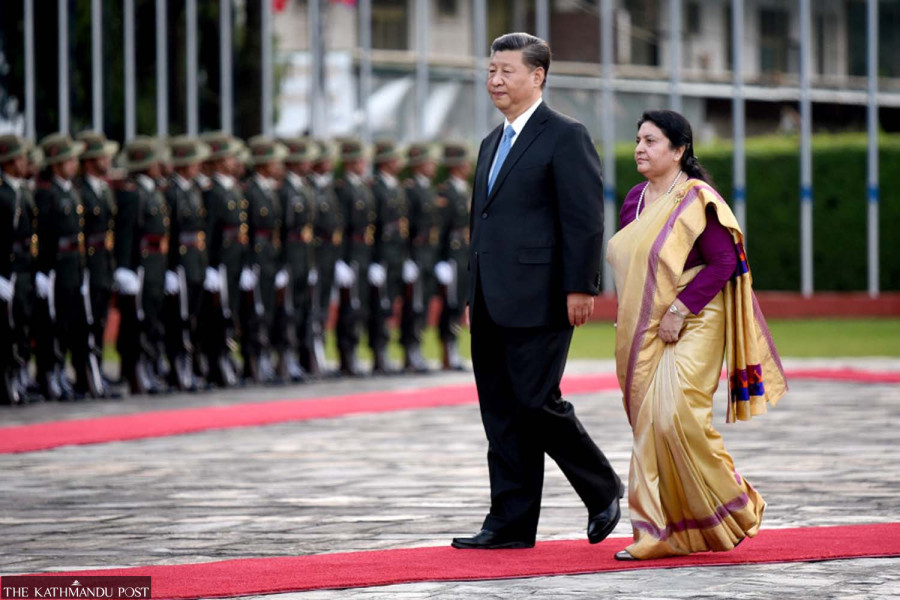National
Xi came, Xi saw but Xi couldn’t conquer hurdles in bilateral ties
Three years since the Chinese President’s historic Nepal visit, there is not much to show for it.
Anil Giri
It has been three years since Chinese President Xi Jinping’s October 2019 Nepal visit, which was described as a “watershed” in Nepal-China relations.
Xi, who is all set to be elected president for another five-year term at the ongoing 20th Congress of the Chinese Communist Party, had vowed to transform ‘landlocked’ Nepal into a ‘land-linked’ country and the two sides signed a slew of agreements during his Kathmandu visit on October 12-13, 2019.
At the visit’s end, a 14-point joint statement was issued and a 20-point list of instruments was signed and exchanged.
Separately, during delegation-level talks with President Bidya Devi Bhandari, Xi had announced an aid worth Rs56 billion to Nepal. Although the money was to be provided over the next two years, negotiations for it still continue between Kathmandu and Beijing. Interestingly, the joint statement did not mention the Rs56 billion promised by Xi.
“We plan to discuss with Chinese authorities matters including the aid promised by Xi as well as the recent Chinese announcement to provide Nepal 800 million RMB [Rs15 billion] for 2022,” said Bishnu Pukar Shrestha, Nepali ambassador to China, over the phone from Beijing.
During a meeting between Foreign Minister Narayan Khadka and his Chinese counterpart Wang Yi in the Chinese city of Qingdao on August 10, the Chinese government had pledged a new aid worth 800 million RMB.
Shrestha said he is waiting for Kathmandu’s nod to start talking with the Chinese authorities.
A Beijing-based Nepali diplomat, meanwhile, said Chinese officials have been saying they have already provided some of the Rs56 billion aid in the form of Covid supplies including vaccines and other assistance. “We will learn the details once we sit for talks with them,” the diplomat said.
There has not been a single meeting between Nepali and Chinese officials in the past three years to discuss the agreements signed three years ago during Xi’s Nepal visit.
But several other matters agreed back then including the joint announcement of the height of Mt Everest, agreements on setting up the Confucius Centre at the Tribhuvan University, developing protocols for export items to China and Mutual Legal Assistance (MLA) on Criminal Matters, high-level exchanges, and holding meetings of bilateral mechanisms have already been implemented, say officials.
“Some projects are making good progress and some are in the initial stages of implementation,” a foreign ministry official said. “Despite being priority issues, we failed to implement some agreements, partly because of the parlaysing Covid pandemic.”
Under the agreement on Mutual Legal Assistance (MLA) on criminal matters, one of the 20 instruments signed and exchanged during Xi’s visit, Nepal in January 2020 extradited around 200 Chinese nationals who were illegally staying and working in Kathmandu.
Similarly, Nepal set up its Office of the Consul General in Chengdu and some Nepali and Chinese cities also established sister-city relations.
One important agreement signed during the visit was a memorandum of understanding between the Ministry of Physical Infrastructure and Transport of Nepal and the Ministry of Transport of China on the Feasibility Study of China-Nepal Cross-Border Railway Project. But Nepali officials are still unsure when the study will start.
As per the joint communiqué released after Xi’s visit, the two sides had committed to implement several projects under the Belt and Road Initiatives, which Nepal signed up to in 2017.
“The two sides agreed to intensify implementation of the Memorandum of Understanding on Cooperation under the Belt and Road Initiative to enhance connectivity, encompassing such vital components as ports, roads, railways, aviation and communications within the overarching framework of trans-Himalayan Multi-Dimensional Connectivity Network,” said the joint statement. The goal being to “significantly contribute to Nepal’s development agenda that includes graduating from LDC at an early date, becoming a middle income country by 2030 and realising the SDGs by the same date.”
But not a single project that Nepal had selected under the BRI has started in the past five years.
In order to execute the BRI projects, Nepali authorities have communicated to the Chinese side that Nepal prefers grants to loans.
Leelamani Poudyal, former Nepali ambassador to China, said the Covid pandemic, change of government in Kathmandu and passage of the US $500 million Millennium Challenge Corporation Nepal Compact despite strong Chinese reservations also affected the BRI projects.
“There were some hindrances in executing the projects agreed during Xi’s visit, but now the two sides need to speed up negotiations to make good of the agreements,” said Poudyal, who was the Nepali ambassador to Beijing during the visit.
One major announcement made by Xi was to transform Nepal from land-locked to land-linked country. But following the pandemic, China has almost shut two key border trading points of Kyrung and Tatopani. China has allowed limited movement of transport and cargoes from Tatopani crossing point, an ancient trading route between Nepal and China, since the 2015 earthquake in Nepal.
“The Tatopani border point remains shut since the earthquake, and Xi’s announcement on Nepal’s transformation from land-locked to land-linked country has not materialised,” said Mrigendra Bahadur Karki, the executive director of the Centre for Nepal and Asian Studies (CNAS). “As China put in place a series of restrictions on transport and business on the Tatopani border, Nepal has been relying more and more on India for bilateral and third-country trade.”
After Xi’s historic visit to Nepal, first by a Chinese president in 23 years, there were apprehensions in Kathmandu that Nepal would tilt towards the north. But that did not happen, said Karki. “It is also because there has been no desired progress on several projects.”
An official at the Finance Ministry, meanwhile, said Chinese officials have recently discussed implementation of some agreed projects. According to the official, the Chinese side has sought the environment impact assessment report on the Tokha-Chhahare tunnel project, and proposed discussing the Araniko Highway upgrade, Bir Hospital extension, and the second phase of the Ring Road widening project covering the Kalanki-Maharajgunj section.
During Xi’s visit, the two sides had agreed to implement the protocol on Nepal’s utilisation of the highway in Tibet for cargo transport as well as the protocol to the Agreement on Transit. But not a single cargo has moved through the Tibetan highway since Nepal and China signed the 2016 transit agreement.
They had agreed to carry out the feasibility study for the construction of tunnels along the road from Kerung to Kathmandu, for the Kimathanka-Leguwaghat section of the Koshi Highway and for the development of three North-South corridors, namely Koshi economic corridor, Gandaki economic corridor and Karnali economic corridor. These corridors would help create jobs, improve local livelihoods, and stimulate economic growth and development.
But none of these agreements have made progress, said officials. Likewise, agreements on the boundary management system, setting up the Madan Bhandari University, imparting training to Nepali technical human resources in the field of railway, road and tunnel engineering, cooperation in hydropower, wind power, solar power, biomass energy as well as the Nepal-China Electric Power Cooperation Plan, among others, await implementation.
“Belying Chinese expectations, BRI projects could not have the desired success in Nepal,” Karki said. “Their political projects, like keeping the [then] Nepal Communist Party intact, failed. Now they are trying to engage with the Nepali Congress, which is a major policy shift. To sum up, Xi’s visit had no substantial impact on Nepal-China ties.”




 11.12°C Kathmandu
11.12°C Kathmandu















